
Film digitalia, profile picture, No. 5 (2019) by Matt Whitman
Friday, July 11, 2025, 11:00 am
SFABF Screening Gallery — Friday, July 11
Cinematheque at the San Francisco Art Book Fair
With the recent unveiling of the Minnesota Street Project Foundation’s majestic Screening Gallery, an exhibition space emerged without parallel in the Bay Area arts community. Featuring state-of-the-art audio/video technology the impressively transformable 3,000-square-foot space allows for near infinite variability in large-scale video presentation. On Thursday, Friday and Saturday during SFABF, San Francisco Cinematheque will activate the Screening Gallery with curated programs of multi-channel film/video work presented across nearly 70 feet of gallery space including multi-channel installation work and single-channel film work expanded and remixed for this weekend only. See the full Screening Gallery schedule here. This series is curated by Steve Polta of San Francisco Cinematheque and is made possible thanks to Minnesota Street Project Foundation.
Friday, July 11
11am: Blue Scrubs, Yellow Scrubs, Trustees All Above / Orange Jumpsuit (2019) by Cauleen Smith (US); digital video, color, sound, 24 minutes. Wild Pitch (2025) by Zach Iannazzi (US); digital video, color, silent, 5 minutes. Trágame nube (el cuerpo establece el ritmo) / The Word Was Deleted (2023) by Esperanza Collado (Spain); 16mm screened as digital video, b&w/color, silent, 13 minutes. Film digitalia, profile pictures, No. 4, 5, 8 & 9 (2019) by Matt Whitman (US); digital video, color, silent, 16 minutes. It’s Just Business, Baby (2023–2024) Ayanna Dozier (US); digital video, b&w/color, silent, 6 minutes. Pure Means (2021) P. Staff (UK); digital video, color, sound, 5 minutes. TRT: 69 minutes.
12:30pm: DROP CITY (2019) by Peter Burr (US); digital video, color, sound, 7 minutes. Stained Glass Daydream (2025) by Jodie Mack; digital video, color, silent, 15 minutes. Coyote / Xiuhtecuhtli / Ritual / Mictlantecuhtli (2023) Colectivo los ingrávidos (Tehuacán); digital video, color, sound, 16 minutes. HOW MUCH LONGER (ON BALLOONS) / CAN’T ANSWER YOU ANY MORE (ON FACES) / MARY (ON FLOWERS) / PHONE IN HAND (ON BALLOONS WITH A SHEET OVER DEAD BELONGINGS) / ALL HER PRECIOUS JPEGS (ON YELLOW) (2019) by Matt Whitman (US); digital video, color, silent, 10 minutes. Field Guide to San Lorenzo Creek, Castro Valley, California (2025) by Michael Damm (US); digital video, color, sound, 8 minutes. TRT: 54 minutes.
1:45pm: WVLNT: WAVELENGTH For Those Who Don’t Have the Time (2003) by Michael Snow (Canada); digital video, color, sound, 15 minutes. PATTERN LANGUAGE (2016) by Peter Burr (US); digital video, color, sound, 11 minutes. Climate Fictions (2017) by Jeanne Liotta (US); digital video, color, sound, 4 minutes. Shimmering Spectacles (2015) by Scott Stark (US); digital video, color, sound, 8 minutes. Warnings in Waiting (2023) by Aura Satz (UK); digital video, color, sound, 24 minutes. TRT: 62 minutes.
3:15pm: Makino Takashi (Japan): Memento Stella (2018); digital video, color, sound, 12 minutes. cinéma concret (2015); digital video, color, sound, 30 minutes. TRT: 42 minutes
Cinematheque at San Francisco Art Book Fair
Screening Gallery
THURSDAY • FRIDAY • SATURDAY
11:00 am
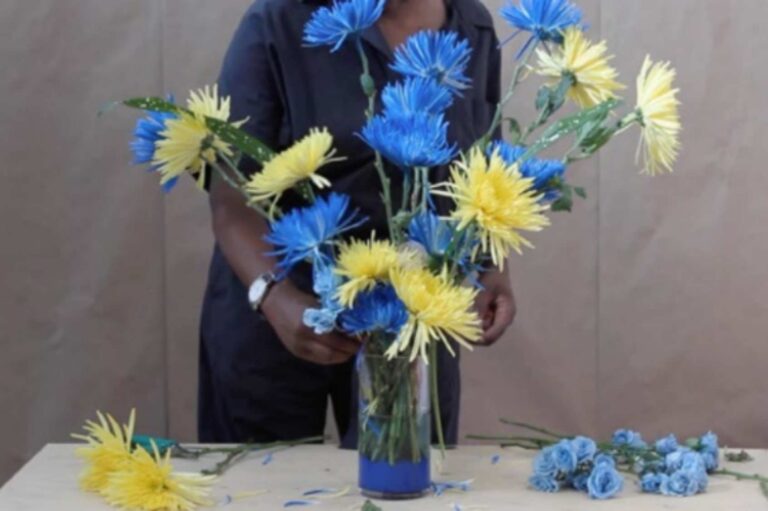
Blue Scrubs, Yellow Scrubs, Trustees All Above / Orange Jumpsuit (2019) by Cauleen Smith
Blue Scrubs, Yellow Scrubs, Trustees, All Above and Orange Jumpsuit were commissioned by Los Angeles Municipal Gallery at Barnsdall for the group show, Loitering is Delightful. Inspired by an essay by Ross Gay about the perils and pleasures of loitering, these videos use a longstanding device within Smith’s practice of the Ikebana to contemplate the vulnerability of black bodies in public space that are not deployed for labor, profit or entertainment. The colors of the flowers are the colors of clothing worn in LA County Jail (yellow and blue) and state prison (orange). (Cauleen Smith)
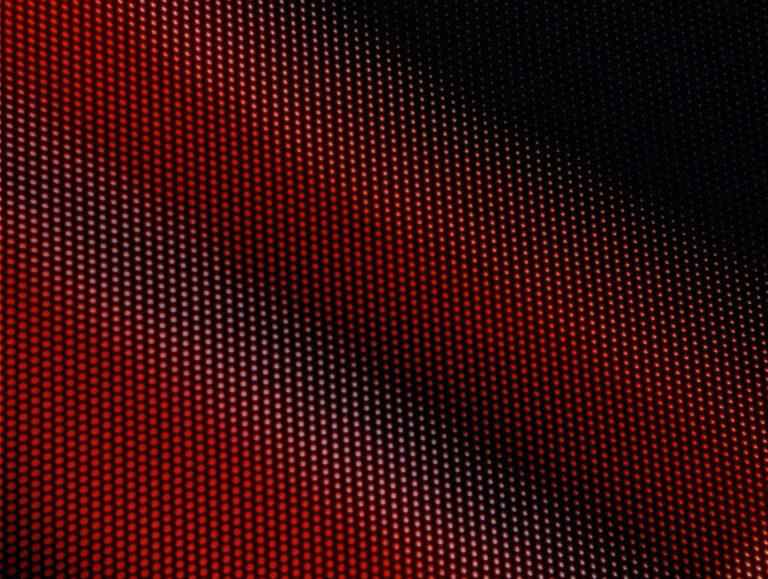
Wild Pitch (2025) by Zach Iannazzi
A pitcher is charged with a wild pitch when their pitch is so errant that the catcher is unable to control it. (Zach Iannazzi)
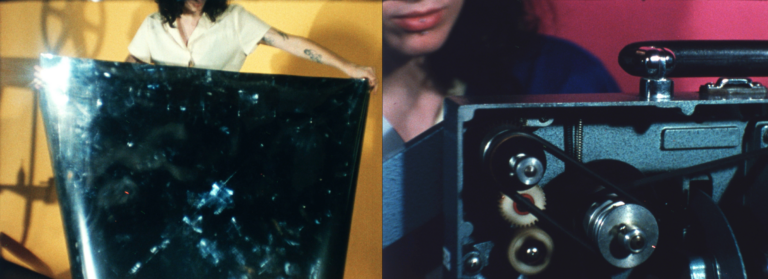
Trágame nube (el cuerpo establece el ritmo) / The Word Was Deleted (2023) by Esperanza Collado
Trágame nube… is a double-sided film inspired by the experimental ideas of Spanish filmmaker and inventor José Val del Omar (1904–1982). It explores cinema’s materiality and spatiality, reconfiguring viewer/image relationships through three sequences shot in the Alhambra Palace of Granada, Madrid and Bilbao. Commissioned 2023 by Museum of Moving Image, New York. (Esperanza Collado) For SFABF, Trágame nube… is presented in a four-channel iteration.
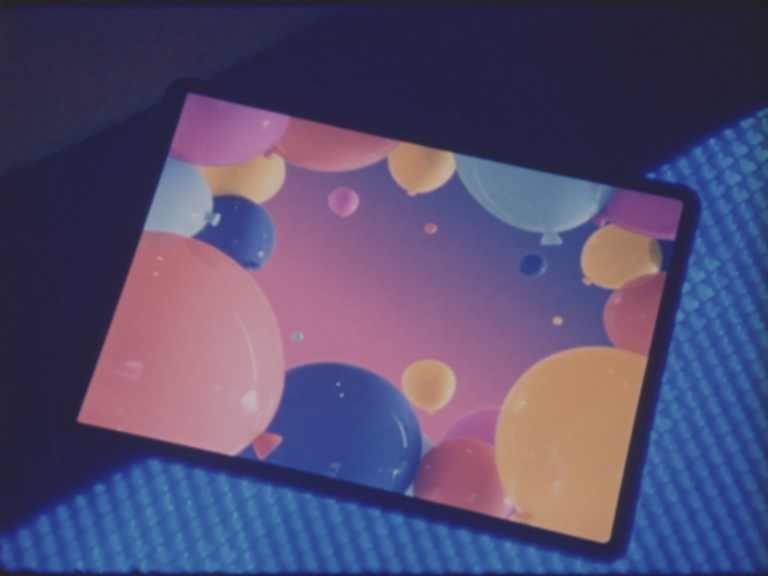
Film digitalia, profile pictures, No. 4, 5, 8 & 9 (2019) by Matt Whitman
Four films from a body of work of textual and archival responses to and documentation of ongoing discrepancies—between living and deceased, public and private, physical and virtual—found in moments of contemporary mourning. Shot on film and edited almost entirely in-camera, the works’ own form points to the material vulnerabilities, susceptibilities and affective properties of the physical archive, particularly alongside artifacts of digital and online memory. These pieces are seen to perpetuate, in vain, a synoptic visual language of social media, while responding to the immediacy and anti-preciousness of written language created for and within a digital social space by allowing it to be made readable only through its recording onto motion picture film. The series Film digitalia, profile pictures documents a performative swiping through a series of texts, inscribed on Facebook backgrounds, revealed one syllable at a time. Some of the texts originate from text messages and verbal conversations (as remembered) with the deceased while some are complete fabrications. Each Facebook background has been chosen based on the content and perceived tones of the text being performed. This performance appears retroactively on an iPad, which has been placed on the surface of an OLED monitor laid flat on the ground. Connected to the monitor is a 4K digital video camera, which is pointed back at the monitor and iPad, creating a feedback loop. The 16mm film camera is, in turn, attached to the digital video camera and records the performance. (Matt Whitman)
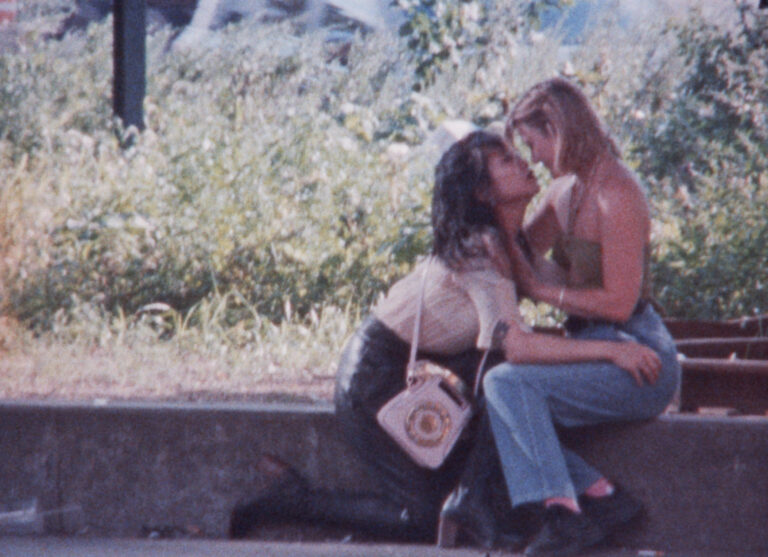
It’s Just Business, Baby (2023–2024) by Ayanna Dozier
The trilogy of silent Super-8mm films titled It’s Just Business, Baby consists of Let’s Make Love and Listen to Death from Above (2023); It’s Just Business, Baby (2023) and Bounded Intimacy (2024). The trilogy examines the histories of various forms of body labor across the Chelsea and Tribeca districts of New York, districts that were renowned as sites for sex work, sex clubs and illicit sexual activity. (Ayanna Dozier)
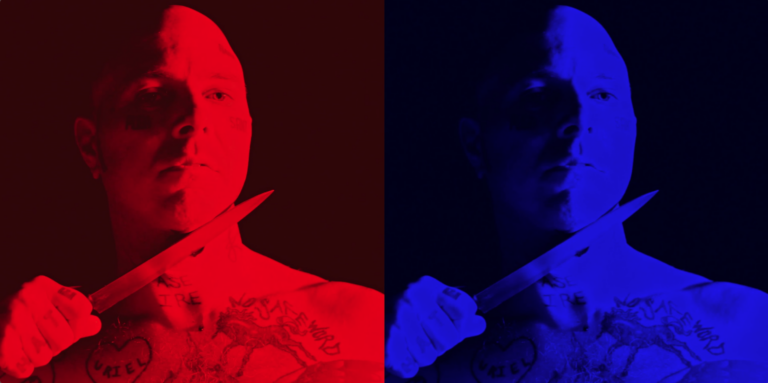
Pure Means (2021) by P. Staff
Pure Means is a two screen video work by P. Staff, shot in a California desert wilderness during the summer of 2021. Through scenes of volatility, inebriation, dreaming and exhaustion, the video observes a frenzied sequence of alluring, cinematic intensity, made in collaboration with LA-based dancer/performer Gregory Barnett. The sequence is rendered in two parallel streams, one coloured blue/one coloured red, mirroring the technology of anaglyph 3D effects and the experimental modes of new wave and expanded cinema. When viewed in tandem, the two streams eventually rupture and split, with one steadily revealing itself as formally and structurally “defective.” Through this hybrid but disjunctive structure, the artist invites the viewer to consider their own position as a viewing subject, raising questions of partiality, perspective and ideals of wholeness and the damaged “other.” (P. Staff) For SFABF, Pure Means is presented in a four-channel iteration.
12:30 pm
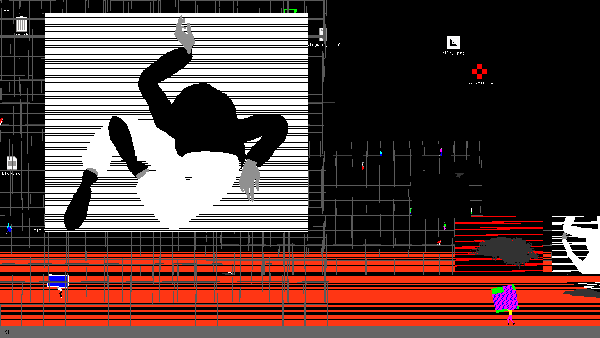
DROP CITY (2019) by Peter Burr
DROP CITY is a portrait of a computer desktop community. It takes its name from the first rural hippy commune in America, a settlement in southern Colorado that formed in 1965 constructed of discarded junk, salvage car tops and other detritus fashioned into inventive living structures. A decade later Drop City was completely abandoned. Nothing is left of it today. The film was commissioned by Daata Editions in 2019. (Peter Burr)
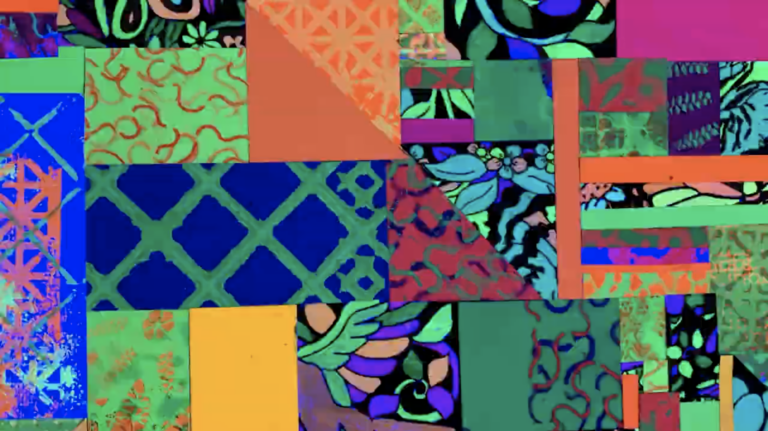
Stained Glass Daydream (2025) by Jodie Mack
Named after animator and kinetic sculptor, Len Lye’s conception of his own abstract filmmaking, Stained Glass Daydream animates handmade painted paper quilts to transform multiple screens into moving stained glass windows. Locating the cinema space within the lineage of proscenia-adjacent communal gathering spaces (music halls, theaters, churches, classrooms), the artisanal animation, illuminated in camera by ultraviolet light, invites ecstatic religious reflection within a secular society. (Jodie Mack)
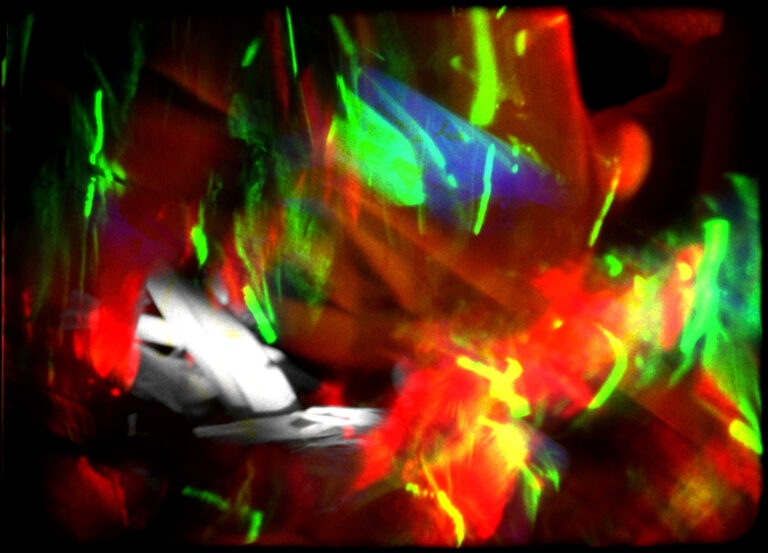
Coyote / Xiuhtecuhtli / Ritual / Mictlantecuhtli (2023) by Colectivo los ingrávidos
Coyote: This is the howl, gaze and agitation of the Coyote into the mountain. The Path of the Coyote. Xiuhtecuhtli: This is a rhythmic invocation of the ancestral fire in which dazzling flames reanimate bones and natural elements. This is the shining of color. Ritual: Through the obsidian mirror the solar and lunar ritual used to be a celestial dance. Mictlantecuhtli: This is the invocation to the ancestral god of the underworld, the ancient annihilator, which preserves the ritual inertia of the bones and stones. (Colectivo los ingrávidos)

HOW MUCH LONGER (ON BALLOONS) / CAN’T ANSWER YOU ANY MORE (ON FACES) / MARY (ON FLOWERS) / PHONE IN HAND (ON BALLOONS WITH A SHEET OVER DEAD BELONGINGS) / ALL HER PRECIOUS JPEGS (ON YELLOW) (2019) by Matt Whitman
Five films from a body of work of textual and archival responses to and documentation of ongoing discrepancies—between living and deceased, public and private, physical and virtual—found in moments of contemporary mourning. Shot on film and edited almost entirely in-camera, the works’ own form points to the material vulnerabilities, susceptibilities and affective properties of the physical archive, particularly alongside artifacts of digital and online memory. These pieces are seen to perpetuate, in vain, a synoptic visual language of social media, while responding to the immediacy and anti-preciousness of written language created for and within a digital social space by allowing it to be made readable only through its recording onto motion picture film. This group of works joins performed texts—including those originating from text and verbal conversations as well as complete fabrications—with documentation of both digital and physical remnants of the deceased. The Super 8mm camera is used as an arbiter of value as clothing, voicemails, plastic candles, .FLV files, pill bottles, .JPEGs and other personal items are sorted through, following a series of unexpected deaths. I’m going to die naked with my phone in my hand too. (Matt Whitman)
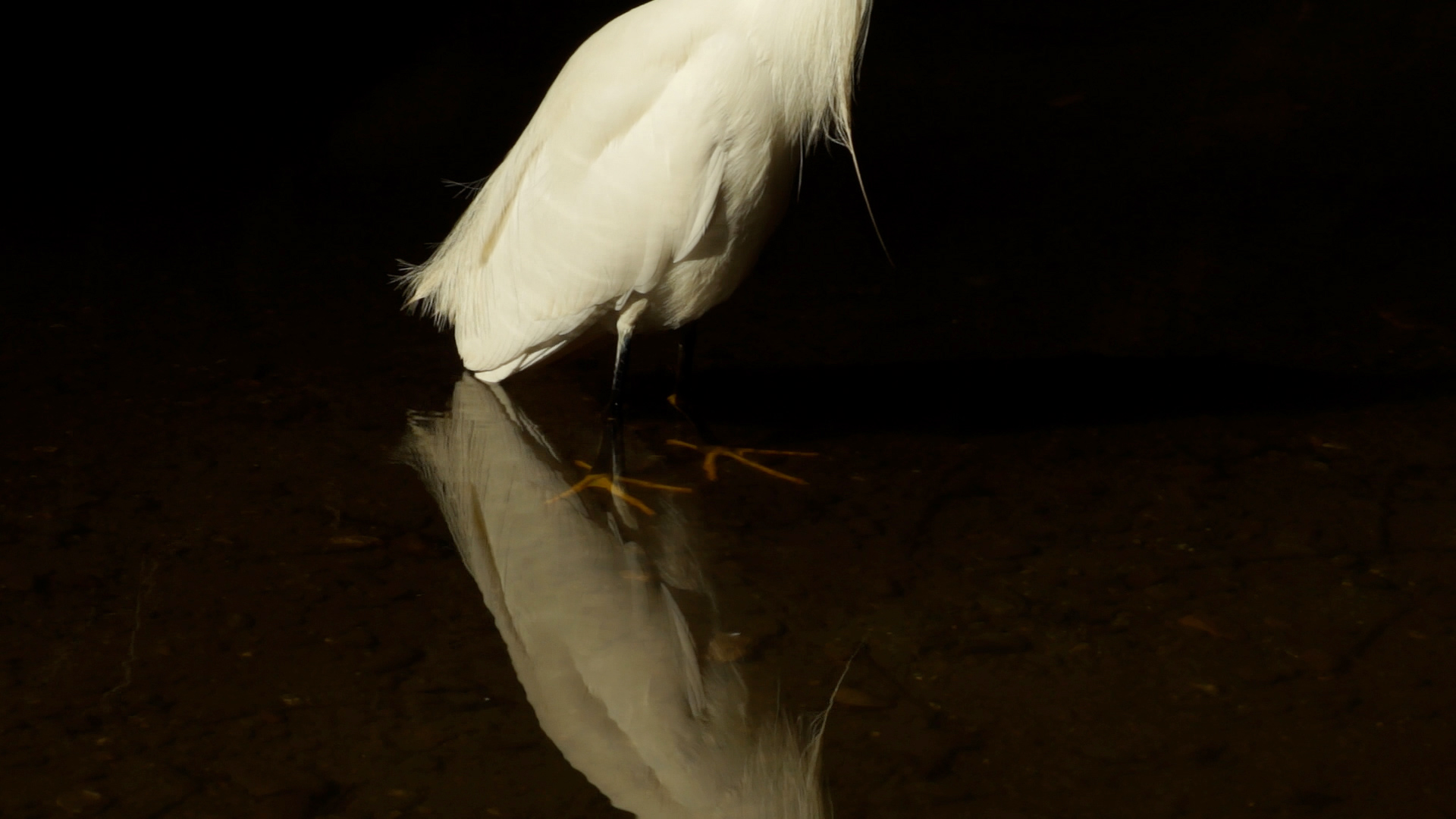
Field Guide to San Lorenzo Creek, Castro Valley, California (2025) by Michael Damm
Field Guide to San Lorenzo Creek, Castro Valley, California reflects on the situation of nature in an age of human-centered climate change. The project comprises seven short films and a multi-channel installation that traverse a small ribbon of wildland in the suburban hills east of the San Francisco Bay. The films record a devastated, wondrous habitat that is everywhere entangled with the proximity of urban space, populated by synanthropic animals, migrating birds, myriad species of native and introduced plants and insects and the incidental movement of light and water. These are nature films that are also city films—lyrical, song-length documentaries of the urban/wildland interface.
1:45 pm

WVLNT: Wavelength For Those Who Don’t Have the Time (2003) by Michael Snow
Michael Snow’s Wavelength has been acclaimed as a classic of avant-garde filmmaking since its appearance in 1967. In February 2003, Snow created a new work consisting of simultaneities rather than the sequential progressions of the original work. WVLNT is composed of three unaltered superimpositions of sound and picture. “A mixture of motives created the impetus for this work. On the one hand there were frequent inquiries as to whether Wavelength was or would be soon available on DVD. My position was that, as long as it was possible, I wanted to show the 16mm film in a cinema auditorium in the way it was intended and the way it is at its best. Simultaneously, I was aware of the (in some ways) wonderful democratization of the Internet in making the means to create and modify movies and sound available to everyone. The other motive was that horrible, bad-copy excerpts from Wavelength and La Région Centrale (Snow, 1971) were appearing on YouTube and other sites. My unreasonable reasoning went like this: If people want Wavelength on DVD, I will make a special digital version that is available to anyone; and If anybody is going to vandalize my work it should be me!” (Michael Snow: Sequences—A History of His Art. Ediciones Poligrafa, Barcelona. 2015.) This one-time-only four-screen presentation of WVLNT is presented at SFABF with the permission of the estate of Michael Snow.
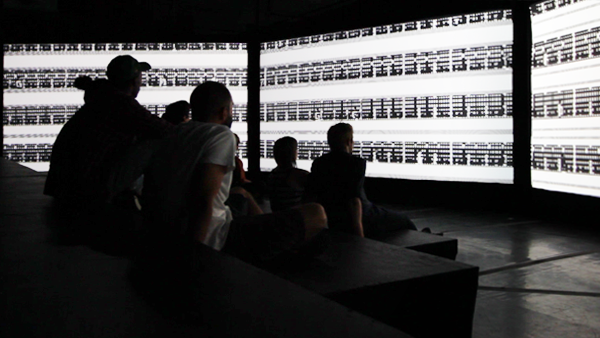
PATTERN LANGUAGE (2016) by Peter Burr
“Pattern Language” is a term coined by architect Christopher Alexander describing the aliveness of certain human ambitions through an index of structural patterns. Some advocates of this design approach claim that ordinary people can use it to successfully solve very large, complex design problems. In this piece, the vocabulary of Alexander’s system is employed towards the construction of an endlessly mutating labyrinth. (Peter Burr)
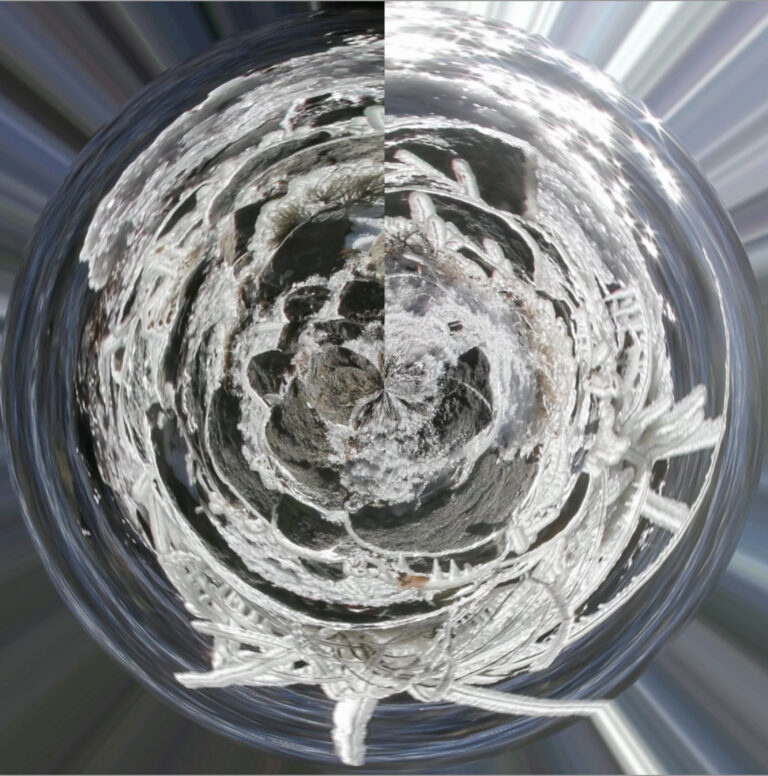
Climate Fictions (2017) by Jeanne Liotta
Basic climate science lead to the speculative visions of these Climate Fictions, a media series of 4 possible dystopic future Earths. All the imagery in Climate Fictions began as photographic landscape reality but were digitally “folded” as a visualization technique to form these planetary spheres. These pieces were created during the research period for my climate change media project Soon It Would Be Too Hot (2014), a commission specifically designed for 360 degree projection on NOAA’s Science on a Sphere. Global warming is happening now and human activity is the primary cause as rising carbon dioxide levels trap heat and drive up the planet’s temperature. (Jeanne Liotta)
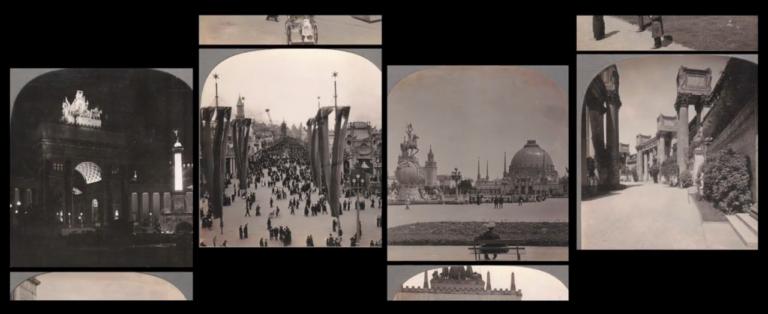
Shimmering Spectacles (2015) by Scott Stark
Using a unique set of original stereoview photographs from the 1915 San Francisco world’s fair (the Panama–Pacific International Exposition), along with contemporary images he shot himself, Scott Stark’s Shimmering Spectacles commemorated the centennial of the 1915 fair, turning the images into “spectacles”—lenses that bring into focus the amazing “spectacles” that comprised this historic moment in San Francisco’s history. (Scott Stark)
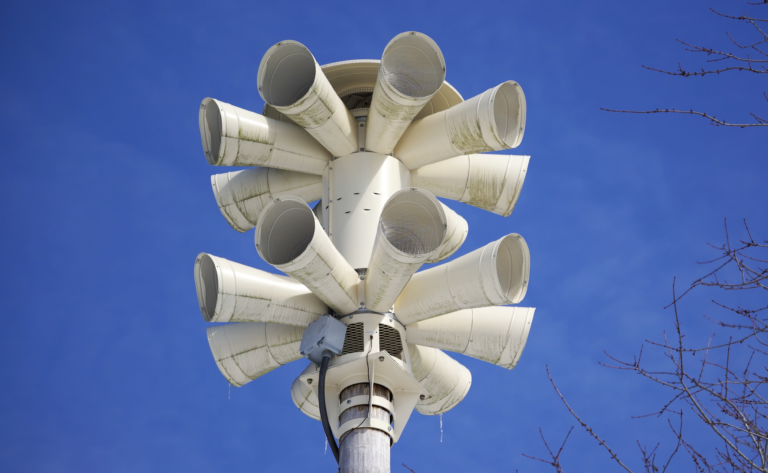
Warnings in Waiting (2023) by Aura Satz
How do we hear and understand emergency signals at a time of intersecting environmental and sociopolitical crises? Does an alarm have to be alarming? And can we imagine sirens beyond the human? Composed of footage shot at sites where sirens are deployed, Aura Satz works collaboratively with a roster of musicians to speculatively reimagine what a siren is. Drawing on Satz’ ongoing documentary film project Preemptive Listening (2017–2024), the three-channel Warnings in Waiting explores the lifecycle of a siren: sirens in situ, placed within landscapes and architectures of threat; sirens in a factory, suspended in a preliminary limbo; and sirens in a state of obsolescence, in a siren “cemetery” or junkyard. The project reimagines sirens in order to forge a new understanding of present and long-term emergency. The siren serves as a worldwide symbol of potential trauma, an emblem warning of climate catastrophe, a mouthpiece for sonic governance and crisis management. Many sirens are relics from WW2 and the cold war, repurposed to communicate the threats of extreme weather, to suggest collective commemorative pause or have been resurrected to test disaster preparedness. The installation consists of films shot across America, Lapland and Fukushima that rotate across different soundscapes, with newly composed siren sounds by an array of experimental musicians. The soundtrack features the endlessly escalating sounds of planetary data; animal howls and the grief of extinction; soaring banshee-like warnings; defiant trumpets; intricate harp permutations; the sounds of the earth’s core. Warnings in Waiting offers an experiment in listening, exploding the soundtrack within a permutational logic specific to the gallery context, and echoing the modular logic of the siren’s code that can be used to communicate diverse messages across war, weather and civil unrest. (Aura Satz)
3:15 pm
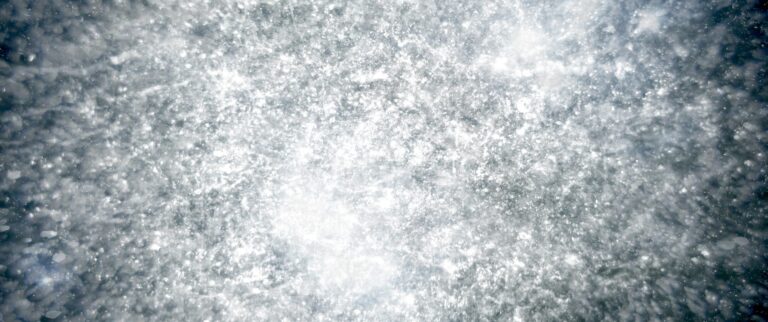
Memento Stella (2018) by Makino Takashi
For several years I’ve traveled the world, screening my work. And throughout this dark, sad world, amid war and terrorism, with countless lives lost to natural cataclysms and human-caused disaster, there hasn’t been a single day that death hasn’t been in my thoughts. At the same time, I do realize that it is not only death that binds us. We are also born, raised and are living on this little planet among the stars. I pursue my work with the idea that if each day, we might be conscious of this truth for even a moment, then maybe perhaps somewhere deep in our hearts, we might find shared artistic expressions, keys to a place beyond the religions, politics, borders, languages and personal desires which tear us apart. (Makino Takashi, December 2017)
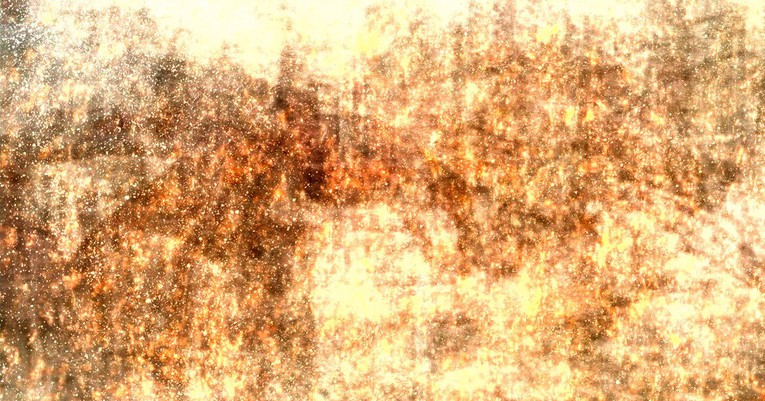
cinéma concret (2015) by Makino Takashi
Music:Machinefabriek. After researching the history of musique concrète, a practice which was developed by Pierre Schaeffer in the 1940s, I found the process of making Concrete Music was identical with my style of filmmaking. The process of “concrete music” is not making concrete music from abstract sounds but making abstract music from concrete sounds (i.e. already existing sounds). The film cinéma concret is then a 21st century response to Pierre Schaeffer and musique concrète and also an ironic interpretation of the history of abstract cinema. (Makino Takashi, May 15, 2015)
Peter Burr (US) is an artist from Brooklyn who transforms complex computational systems into emotional, sensory experiences through large-scale immersive environments. Drawing from early experiments with computational graphics in the mid-’90s, Burr’s practice has evolved to incorporate techniques that merge fundamental computing operations with modern real-time rendering systems. His work frequently explores the relationship between human–machine interfaces and the underlying systems that drive them. His practice has been recognized through grants and awards including a Guggenheim Fellowship, a Creative Capital Grant and a Sundance New Frontier Fellowship. His work has been presented at major cultural institutions including the Museum of Modern Art, The Barbican Centre, Documenta 14, the Whitney Museum of American Art and the Centre Pompidou. Throughout his career, Burr has maintained an active presence in the computational arts field, with exhibitions in over twenty-five countries. He regularly presents his research at institutions including past keynotes at Yale University and Ars Electronica. He is a current PhD candidate in video games at Rensselaer Polytechnic Institute.
Colectivo los ingrávidos (Tehuacán, Mexico) arises from the need to dismantle the audiovisual grammar that the aesthetic-television-cinematic corporatism has used and uses to effectively guarantee the diffusion of an audiovisual ideology by means of which a continuous social and perceptive control is maintained over the majority of the population. Politically charged yet involved with the sublime, Los Ingrávidos inhabit poetic realms that few dare to tread.
Esperanza Collado (Spain) is an artist and researcher working at the intersection of film, performance and installation. Her practice explores the dematerialization of cinema and its articulation beyond the screen, often engaging with ephemeral formats, spatial montage and the physical presence of the viewer. Collado’s work is informed by her extensive research into expanded cinema and its legacy. She holds a PhD on the concept of paracinema and has presented her work across Europe, the United States, Latin America and Asia at venues such as Anthology Film Archives (New York), Light Cone (Paris), Museo Reina Sofía (Madrid) and Image Forum (Tokyo). She is the author of the award-winning book Paracinema: la desmaterialización del cine en las prácticas artísticas (Trama 2012) and co-founder of the experimental record label LEVE.
Ayanna Dozier, PhD is a Brooklyn-based artist-writer. Her art practice centers performance, experimental film, printmaking and photography, using auto-fiction, surrealist, conceptual and feminist methods. Her research on film navigates the history of distribution, archaeology and radical work of Black feminist experimental filmmakers while her current research and artwork is dedicated to examining how transactional intimacy (like sex work) redistributes care from the private sector into the public, social politics of relations. She is currently an assistant professor in communication, emphasis in film, at the University of Massachusetts, Amherst and is the author of Janet Jackson’s The Velvet Rope (2020).
Zach Iannazzi (US) is an artist who makes films and lives in Berkeley, California.
Jeanne Liotta (US) makes films, videos, and other ephemera including installation, projector performances, works on paper and photography. Her works have exhibited internationally, including the New York Film Festival; the International Film Festival Rotterdam; the Whitney Biennial; the Sharjah Biennial; the Centre George Pompidou’ the Cinémathèque Français; the Arthouse/Jones Center, Austin TX; The Exploratorium, San Francisco; The Wexner Center for the Arts, Ohio; the Museum of Contemporary Art Denver and the Cornell Astronomical Society amongst other venues.
Jodie Mack (US/UK) is an experimental animator who received her MFA in film, video and new media from The School of the Art Institute of Chicago in 2007. Combining the formal techniques and structures of abstract/absolute animation with those of cinematic genres, her handmade films use collage to explore the relationship between graphic cinema and storytelling, the tension between form and meaning. Musical documentary or stroboscopic archive: her films study domestic and recycled materials to illuminate the elements shared between fine-art abstraction and mass-produced graphic design. The works unleash the kinetic energy of overlooked and wasted objects and question the role of decoration in daily life.
Aura Satz (UK) is a London-based visual artist whose work encompasses film, sound, performance and sculpture. Her work explores modes of listening as both subject matter and medium, often considering the role that technologies play in these alternative soundscapes. Satz has worked with a wide range of contemporary composers, vocalists, and sound artists, frequently using this collaborative practice to trace the lineage of the unsung women pioneers of electronic music.
Cauleen Smith (US) was raised in Sacramento CA and lives in Los Angeles. Smith is faculty in the UCLA School of Arts and Architecture. Smith holds a BA in Creative Arts from San Francisco State University and an MFA from the UCLA School of Theater Film and Television. Smith has had solo exhibitions at The Whitney Museum of American Art, MassMoCA and LACMA. Smith is the recipient of the following awards: Rockefeller Media Arts Award, Creative Capital Film/Video, Chicago 3Arts Grant, the Foundation for Contemporary Arts, Chicago Expo Artadia Award, Rauschenberg Residency, Herb Alpert Awards in the Arts in Film and Video, United States Artists Award, the Ellsworth Kelly Award, the Studio Museum Joyce Alexander Wein Artist Prize and a 2021 Guggenheim Fellowship.
Michael Snow (Canada). “I am not a professional. My paintings are done by a filmmaker, sculpture by a musician, films by a painter, music by a filmmaker, films by a musician, music by a sculptor… sometimes they all work together. Also many of my paintings have been done by a painter, sculpture by sculptor, films by a filmmaker, music by a musician.” (Michael Snow, 1967)
P. Staff (UK) lives and works in Los Angeles and London. Their work combines video installation, performance and publishing to interrogate notions of discipline, dissent, labour and the queer body. They have exhibited extensively, gaining significant recognition and awards for their work which is held in private and public collections internationally. Staff received their BA in Fine Art and Contemporary Critical Studies from Goldsmiths University of London in 2009.
Scott Stark (US) has made over 85 films and videos as well as numerous moving image installations, live performances and photo-collages. His work has shown nationally and internationally in venues as diverse as New York’s Museum of Modern Art, San Francisco Cinematheque, the International Film Festival Rotterdam, Tokyo Image Forum and many others. His 16mm film Angel Beach (2001) was invited into the 2002 Whitney Biennial and in 2007 he received a Guggenheim Fellowship. He lives in San Francisco, California.
Makino Takashi (Japan, b. 1978) is a Tokyo-based experimental filmmaker widely considered to be one of the most influential Japanese moving-image artists of his generation. After graduating from the cinema department at Nihon University College of Art, he spent time honing his skills in the London-based studio of the Quay Brothers before moving back to Japan. His unique working process usually involves capturing representational footage of humans, nature and urban life in various formats and then transforming these images radically during the editing stage. Through a process of layering, superimposition and other formal manipulations, these concrete images blend together into pulsating visual fields of organic abstraction in his finished works. Makino regularly presents installations, screenings and audio-visual performances of his work internationally, having appeared in over 120 cities to date.
Matt Whitman (US) is an artist and filmmaker working with 16mm and Super-8mm motion picture film. His films have recently screened at the Chicago Underground Film Festival, the Winnipeg Underground Film Festival, Ann Arbor Film Festival, ANALOGICA, Fracto Experimental Film Encounter, Kinoscop, Process Festival, Light Matter, Light Field, Microscope Gallery and other venues. He lives and works in Brooklyn and has taught at Parsons School of Design since 2014.